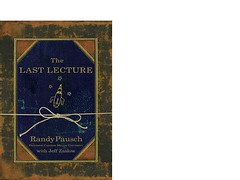“The Last Lecture” provides message for family, friends
“I thanked the audience for coming, cracked a few jokes, and then I said: ‘In case there’s anybody who wandered in and doesn’t know the back story, my dad always taught me that when there’s an elephant in the room, introduce it. If you look at my CT scans, there are approximately ten tumors in my liver, and the doctors told me I have three to six months of good health left. That was a month ago, so you can do the math,’” wrote Randy Pausch, author of “The Last Lecture.”
Paush, a prestigious professor at Carnegie Mellon, recently passed away due to pancreatic cancer, but not before leaving a message behind for his family and friends.
“The Last Lecture” is a novel comprised of several short stories that were meaningful and influential aspects of Pausch’s life.
By Stephanie Wytovich
Staff Writer
“I thanked the audience for coming, cracked a few jokes, and then I said: ‘In case there’s anybody who wandered in and doesn’t know the back story, my dad always taught me that when there’s an elephant in the room, introduce it. If you look at my CT scans, there are approximately ten tumors in my liver, and the doctors told me I have three to six months of good health left. That was a month ago, so you can do the math,’” wrote Randy Pausch, author of “The Last Lecture.”
Paush, a prestigious professor at Carnegie Mellon, recently passed away due to pancreatic cancer, but not before leaving a message behind for his family and friends.
“The Last Lecture” is a novel comprised of several short stories that were meaningful and influential aspects of Pausch’s life.
While the tone is sad, you can’t help but smile through the tears while reading it, because you realize that he lived such a full life filled with passion, love, and excitement, and that he continues to share that with us even after he has passed.
The book discusses first how he found out about the cancer, and then continues explaining his feelings and actions after he had accepted it. He goes through ups and downs with his disease, but stays optimistic throughout the entire novel.
Never before have I read a story of someone so pure of heart and so inspiring, that they could still love themselves and others as much through death as they could through life.
The hardest part of the novel to accept is the fact that he is leaving behind his wife, Jai, with their three children, Dylan (6), Logan (3), and Chloe (18 months).
The book is not about dying, but rather how to live. It’s an inspirational novel that shows you how to live your life, how you want to live it, and to never settle for anything less than what you want or deserve.
It’s a story about how to be optimistic even when your life falls apart. I would truly recommend this book to anyone, and to those of all ages. It teaches you the value of life, and instills life lessons that everyone can relate to.
I’ll leave you with my favorite piece of advice that I learned from Paush. There is one point in the novel when he asks himself, “Am I a fun-loving Tigger, or a sad-sack Eeyore?”
The question presented here is one that we should all ask ourselves.
Are we living in the moment, and making the best of the situation? Or are we dwelling on the negatives?
Strive to be that Tigger. Strive to understand the beauty in life and the importance of smiling.
Strive to live each day like you were dying, and accept the gift of life with the same attitude that Pausch did, because life is fragile and you never know when it’s going to end.
